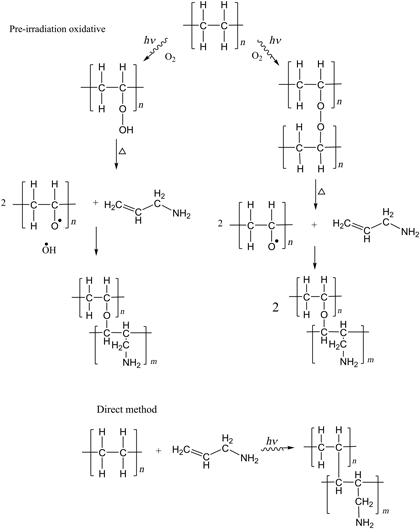Crossref Citations
This article has been cited by the following publications. This list is generated based on data provided by
Crossref.
Pérez-Calixto, M.
Huerta, L.
and
Burillo, G.
2019.
Amine modifications of polypropylene films by gamma radiation to be applied in cell cultures.
MRS Communications,
Vol. 9,
Issue. 4,
p.
1323.
Vázquez, Elizabeth
Muro, Claudia
Illescas, Javier
Burillo, Guillermina
Hernández, Omar
and
Rivera, Ernesto
2020.
Obtainment and Characterization of Hydrophilic Polysulfone Membranes by N-Vinylimidazole Grafting Induced by Gamma Irradiation.
Polymers,
Vol. 12,
Issue. 6,
p.
1284.
Rodríguez-Alba, Efraín
Dionisio, Nestor
Pérez-Calixto, Mitzi
Huerta, Lázaro
García-Uriostegui, Lorena
Hautefeuille, Mathieu
Vázquez-Victorio, Genaro
and
Burillo, Guillermina
2020.
Surface modification of polyethylenterephthalate film with primary amines using gamma radiation and aminolysis reaction for cell adhesion studies.
Radiation Physics and Chemistry,
Vol. 176,
Issue. ,
p.
109070.
Rosado, David
Meléndez-Ortiz, H. Iván
Ortega, Alejandra
Gallardo-Vega, Carlos
and
Burillo, Guillermina
2020.
Modification of poly(tetrafluoroethylene) with polyallylamine by gamma radiation.
Radiation Physics and Chemistry,
Vol. 172,
Issue. ,
p.
108766.
Cornejo-Bravo, José M.
Palomino, Kenia
Palomino-Vizcaino, Giovanni
Pérez-Landeros, Oscar M.
Curiel-Alvarez, Mario
Valdez-Salas, Benjamín
Bucio, Emilio
and
Magaña, Héctor
2021.
Poly(N-vinylcaprolactam) and Salicylic Acid Polymeric Prodrug Grafted onto Medical Silicone to Obtain a Novel Thermo- and pH-Responsive Drug Delivery System for Potential Medical Devices.
Materials,
Vol. 14,
Issue. 5,
p.
1065.
Guselnikova, Olga
Semyonov, Oleg
Sviridova, Elizaveta
Gulyaev, Roman
Gorbunova, Alina
Kogolev, Dmitry
Trelin, Andrii
Yamauchi, Yusuke
Boukherroub, Rabah
and
Postnikov, Pavel
2023.
“Functional upcycling” of polymer waste towards the design of new materials.
Chemical Society Reviews,
Vol. 52,
Issue. 14,
p.
4755.
Štěpánková, Kateřina
Ozaltin, Kadir
Sáha, Petr
Vargun, Elif
Domincová-Bergerová, Eva
Vesel, Alenka
Mozetič, Miran
and
Lehocký, Marian
2024.
Carboxymethylated and Sulfated Furcellaran from Furcellaria lumbricalis and Its Immobilization on PLA Scaffolds.
Polymers,
Vol. 16,
Issue. 5,
p.
720.
Štěpánková, Kateřina
Müllerová, Markéta
Žídek, Štěpán
Pištěková, Hana
Urbánek, Pavel
Sťahel, Pavel
Trunec, David
Popelka, Anton
Kallingal, Nithusha
Mozetič, Miran
and
Lehocky, Marian
2025.
Plasma Polymerization of Pentane and Hexane for Antibacterial and Biocompatible Thin Films.
Plasma Processes and Polymers,
Vol. 22,
Issue. 4,


